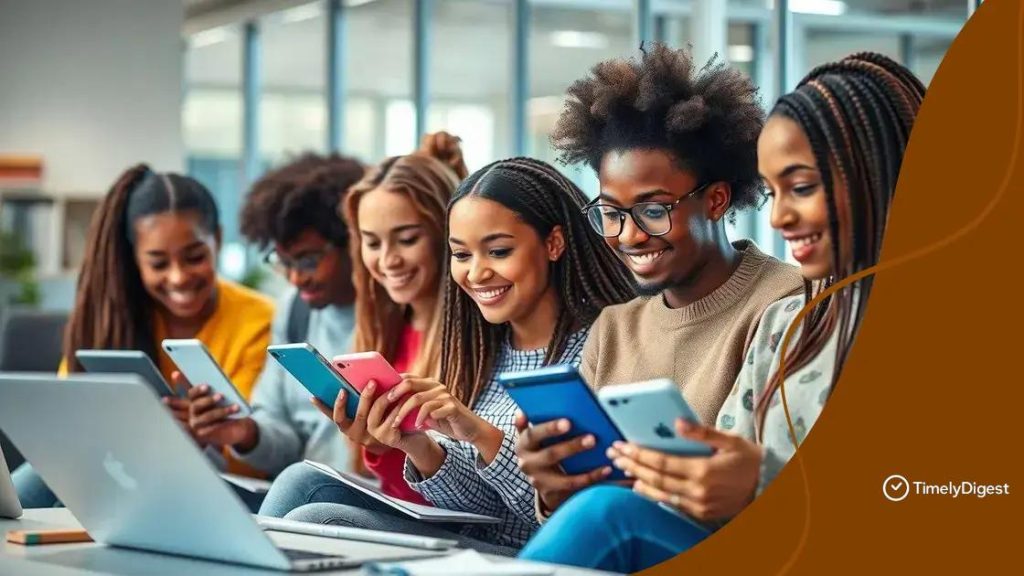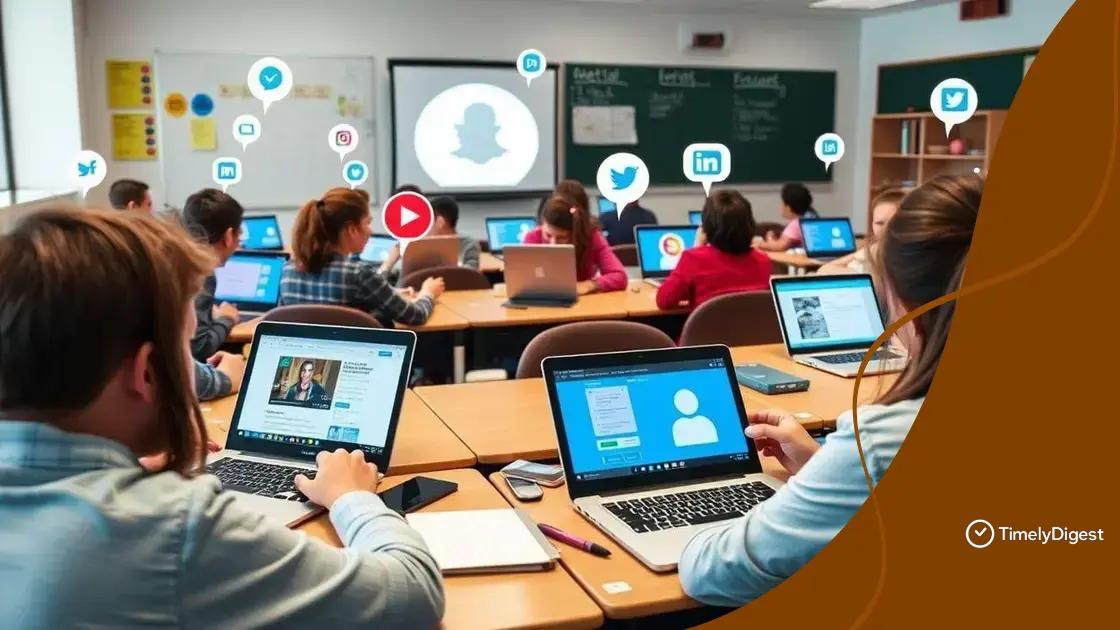Social media on learning: how online platforms transform education

Anúncios
Social media enhances learning by providing engaging platforms for collaboration, access to diverse resources, and opportunities for developing digital citizenship, while also presenting challenges like distractions and privacy concerns.
Social media on learning offers unique opportunities for education, reshaping how students and teachers interact. Have you ever wondered how these platforms can enhance your learning experience? Let’s dive in!
Anúncios
The role of social media in modern education
Social media plays a significant role in modern education by transforming how students learn and connect. With online platforms, learners can access a wealth of resources and engage with their peers and teachers effectively.
Enhancing Communication
One of the primary benefits of social media in education is its ability to enhance communication. Students can easily reach out to each other and their instructors, fostering a collaborative learning environment. This instant connectivity allows for quick feedback and support, making learning more interactive and engaging.
Access to Resources
Additionally, social media serves as a gateway to countless educational resources. Platforms such as YouTube, Twitter, and LinkedIn provide access to tutorials, expert insights, and discussions on various topics. Students can follow educational accounts to stay updated on the latest trends and best practices in their fields.
Anúncios
- Online tutorials and webinars from industry experts.
- Discussion groups for peer learning and support.
- Access to educational articles and research papers.
Furthermore, social media promotes the sharing of ideas and diverse perspectives. Students can engage in discussions beyond the classroom, enriching their understanding of different subjects. This exposure to varied viewpoints helps critical thinking and broadens their educational experience.
Building a Learning Community
By participating in social media groups or forums related to their studies, students can build a sense of community. They can collaborate on projects, share resources, and motivate one another. This sense of belonging can significantly enhance their learning journey and foster a supportive atmosphere.
Moreover, educators can use social media to connect with their students on a more personal level. Sharing real-world experiences and insights through these platforms can inspire learners and deepen their interest in the subject matter.
Benefits of online platforms for learning
Online platforms for learning offer numerous benefits that enhance the educational experience for students of all ages. By utilizing digital resources, students can study at their own pace and access a wide variety of materials.
Flexibility and Accessibility
One major advantage of online learning platforms is their flexibility. Students can choose when and where they want to learn. This access allows individuals with busy schedules or unique circumstances to fit education into their lives more easily.
Through online platforms, learners can participate in courses, watch lectures, and complete assignments anytime, maximizing their potential. Additionally, these platforms are available 24/7, which caters to different learning styles and preferences.
- Students can learn from various locations, such as home, cafes, or libraries.
- Access to courses from different educational institutions worldwide.
- Ability to revisit lectures or materials as needed for better understanding.
Online learning not only provides flexibility but also broadens access to quality education. Many platforms offer courses that might not be available locally, making it possible for students to learn from the best educators in their fields.
Personalized Learning Experience
Another key benefit of using online platforms is the ability to customize the learning experience. Students can select subjects that interest them and focus on areas where they require more help. Through assessments and quizzes, learners can gauge their understanding and adjust their study strategies accordingly.
This personalized approach helps students stay engaged and motivated, as they are more in control of their learning path. Moreover, many platforms use algorithms to suggest content based on a user’s performance, allowing for continuous improvement.
In addition, social features on these platforms foster collaboration and communication among users. Students can connect with peers and instructors, forming study groups or discussion boards. Such interactions not only enhance learning but also create a sense of community.
How to effectively use social media in education

Using social media effectively in education can greatly enhance the learning experience. Educators and students alike can benefit from engaging on these platforms in meaningful ways. By understanding the best practices for integrating social media into the learning process, both teachers and learners can maximize their potential.
Establish Clear Guidelines
First, it is essential to establish clear guidelines for social media use in the classroom. This helps create a safe and respectful environment. Teachers should explain the purpose of using these platforms and set expectations for behavior. By doing so, students will understand how to interact positively with their peers.
In addition, guidelines should cover privacy considerations and what types of content are appropriate to share online. Encouraging students to think critically about their online presence can lead to better engagement.
- Define acceptable platforms for classroom use.
- Discuss privacy settings and data protection.
- Encourage respectful communication and collaboration.
Moreover, teachers can create specific hashtags for class discussions or assignments. This way, students can easily find and share relevant posts, fostering a strong learning community. By using interactive tools like polls or discussions on platforms like Twitter, classes can engage in lively conversations that expand their understanding of the subject matter.
Encourage Collaboration and Engagement
Another effective way to use social media is to promote collaboration among students. Group projects can be organized on platforms where students can share ideas and resources. This not only helps them learn from one another but also builds teamwork skills. For instance, students can use Facebook groups or Slack to communicate and coordinate efforts on assignments.
Social media can also make learning more engaging through multimedia elements. Students can share videos, infographics, and articles related to their subjects. This diverse content allows them to express their creativity and deepen their understanding. Additionally, educators can provide feedback through these platforms, enhancing the learning cycle.
Utilizing social media for educational purposes empowers students and helps them develop their digital literacy skills. As they navigate these platforms, they learn how to curate content, engage with others, and connect with experts in their fields, preparing them for the future.
Challenges of using social media for learning
While social media offers many benefits for learning, there are also significant challenges that users must navigate. Recognizing these obstacles is essential for maximizing the potential of educational platforms.
Distraction and Information Overload
One of the main challenges is the potential for distraction. Social media platforms are filled with content that can divert students’ attention away from their studies. Notifications, updates, and unrelated posts can all lead to a loss of focus.
Additionally, the vast amount of information available can be overwhelming. Students may struggle to identify credible sources or filter through irrelevant content. This situation can hinder effective learning and make it harder to retain important information.
- Strategies to minimize distractions include setting specific study times.
- Educators can guide students to reliable resources, enhancing their research skills.
- Creating a conducive study environment free from social media interruptions.
By acknowledging these challenges, students can develop strategies to maintain focus and enhance their learning experience.
Privacy Concerns
Another significant issue is the concern over privacy and security. Many students may not be aware of the information they share online and how it can impact their personal privacy. This lack of awareness can expose them to risks such as cyberbullying or identity theft.
To address these concerns, educators need to teach students about safe online practices. Understanding how to adjust privacy settings and recognize the importance of protecting personal information is crucial. Additionally, schools should emphasize the need for respectful online behavior to create a safe learning environment.
Social media can be a double-edged sword, offering opportunities for connection while also posing risks. By promoting digital citizenship and responsible social media use, educators can help students navigate these challenges effectively.
Future trends in educational social media
The future of educational social media is bright and full of exciting possibilities. As technology continues to evolve, so too will the ways students and educators engage with each other online. Understanding these trends can help users prepare for what’s coming next.
Increased Use of Video Content
One major trend is the increasing use of video content in education. With platforms like YouTube and TikTok gaining popularity, educators are beginning to create short, engaging videos that explain concepts clearly. This format captures attention and makes learning more enjoyable.
Video content allows for visually rich lessons that can supplement traditional teaching methods. Students can learn from various perspectives by watching demonstrations or tutorials created by peers and experts alike.
- Short video clips to explain difficult concepts.
- Live streaming classes and Q&A sessions.
- Interactive videos that engage students.
This shift toward visual learning also supports diverse learning styles, accommodating students who may struggle with text-heavy materials.
Growth of Collaborative Learning Platforms
Another trend is the growth of collaborative learning platforms that facilitate teamwork among students. Tools like Google Classroom and Slack are becoming essential for project-based learning. These platforms provide spaces where students can work together, share resources, and communicate effectively.
Such collaboration not only enhances learning but also helps students develop important social skills. In the future, expect to see more features integrated into these platforms to support group projects, such as enhanced file sharing and project management tools.
As students collaborate across distances, they build relationships and learn from each other’s strengths. The ability to work with diverse teams prepares them for the global workforce.
Emphasis on Digital Citizenship
With the rise of social media in education, there’s an increasing emphasis on teaching digital citizenship. Students need to understand not only how to use social media responsibly but also how to recognize misinformation and engage positively online.
Educational institutions will likely incorporate digital citizenship training into their curriculums, helping students appreciate the implications of their online actions. Teaching students to navigate the online world safely will be essential for fostering a respectful digital environment.
FAQ – Frequently Asked Questions about Social Media in Education
How can social media enhance student engagement?
Social media can enhance student engagement by providing interactive platforms for discussion, collaboration, and sharing educational content.
What are the challenges of using social media for learning?
Challenges include distractions, privacy concerns, and the potential for information overload that can hinder the learning process.
What role does digital citizenship play in education?
Digital citizenship teaches students to use technology responsibly, engage positively online, and be aware of privacy and security issues.
How is video content changing educational practices?
Video content is changing educational practices by providing accessible, engaging materials that cater to different learning styles and simplify complex concepts.